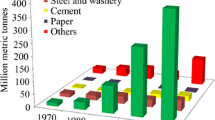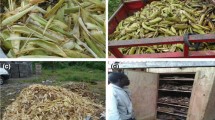Abstract
India is having limited resources of coking coal, an essential input for production of iron and steel especially through blast furnace route. The coking coal sources are presently from the lower seams of Jharia coalfield, which are high in ash content and low in volatile matter and difficult to wash. This paper describes the washability characteristics of a typical coking coal from the Eastern and Western Jharia coalfields aiming at 18% ash level in the clean coal mainly to meet the specifications of coke making for blast furnace use. Conventional float-and-sink testing was used to determine the yield of clean coal for the coarser fraction, while the coal fines was subjected to flotation. The theoretical recovery of clean coal for the coal tested from Eastern and Western Jharia coalfields are 27% and 19.7% at the stipulated ash content. The coking propensities and the petrographic analysis of the clean coal strongly support its use for coke making either directly or as a blend with imported coal.


Similar content being viewed by others
REFERENCES
Geological Survey of India (GSI) Report, Inventory of Indian Coal Resources, New Delhi: Gov. India, 2010.
Fox, C.S., The Jharia Coal Field, Mem. Geol. Surv. India vol. 56, Calcutta, 1930, p. 248.
Mehta, D.R.S., Murthy, B.R.N., et al., A Revision of the Geology and Coal Resources of the Jharia Coalfield, Mem. Geol. Surv. India vol. 84, Delhi, 1957, p. 142.
Sen, K., Chaudhuri, S.G., and Narasimhan, K.S., Nature of low volatile coals of Jharia and their preparation aspect, Proc. Int. Conf. “Asia Energy Vision-2020,” November 15–18, 1996, New Delhi, 1996, pp. 67–74.
Sen, K., et al., Multi product beneficiation of inferior coals to user specific products, Proc. XIV Int. Coal Preparation Congr. and Exhibition, Sandton, South Africa, Johannesburg, 2002, pp. 21–28.
Gouri Charan, T., et al., Washability and pilot plant studies to generate bulk cleans at desired qualities from low volatile coking coal of Jharia coalfields, BCCL, CIL India, Proc. Int. Coke Conf. “Coking Coals and Coke Making: Challenges and Opportunities,” Ranchi: Res. Dev. Centre Iron Steel, 2009, pp. 219–229.
IS 1350:Part 1:1984(R2007): Methods of Test for Coal and Coke—Part I : Proximate Analysis, Old Delhi: Bureau Indian Stand., 2007.
IS 1353:1993(R2000): Methods of Test for Coal Carbonization—Caking Index, Swelling Number and Grey-King Assay (L.T), Old Delhi: Bureau Indian Stand., 2000.
ISO 7404-3:2009: Methods for the Petrographic Analysis of Coals—Part 3: Method of Determining Maceral Group Composition, Geneva: Int. Stand. Org., 2009.
ISO 7404-5:2009: Methods for the Petrographic Analysis of Coals—Part 5: Method of Determining Microscopically the Reflectance of Vitrinite, Geneva: Int. Stand. Org., 2009.
ACKNOWLEDGMENTS
The authors are thankful to The Director, CIMFR for permitting to publish this paper in the Journal. They are also thankful to the entire team of Coal Preparation Division at CIMFR, Digwadih Campus for their cooperation, help and support rendered from time to time.
Author information
Authors and Affiliations
Corresponding author
About this article
Cite this article
Chattopadhyay, U.S., T. Gouri Charan Utilization of High Ash, Low Volatile Coking Coals of Jharia Coalfield, India for Coke Making. Coke Chem. 64, 12–17 (2021). https://doi.org/10.3103/S1068364X21010026
Received:
Revised:
Accepted:
Published:
Issue Date:
DOI: https://doi.org/10.3103/S1068364X21010026




